美国大学英语写作:Chapter 13_对比和比较
- 格式:pptx
- 大小:169.18 KB
- 文档页数:14
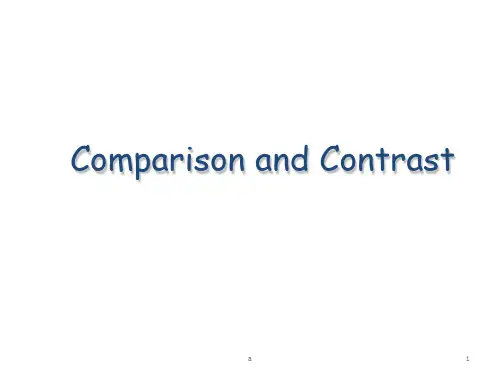
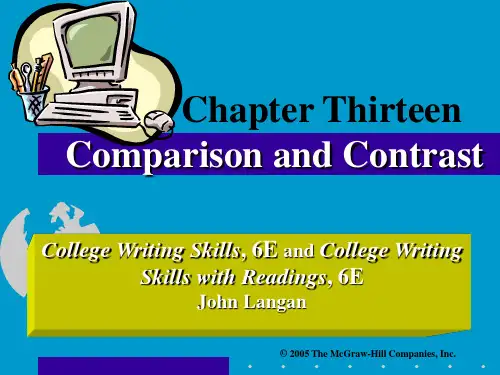
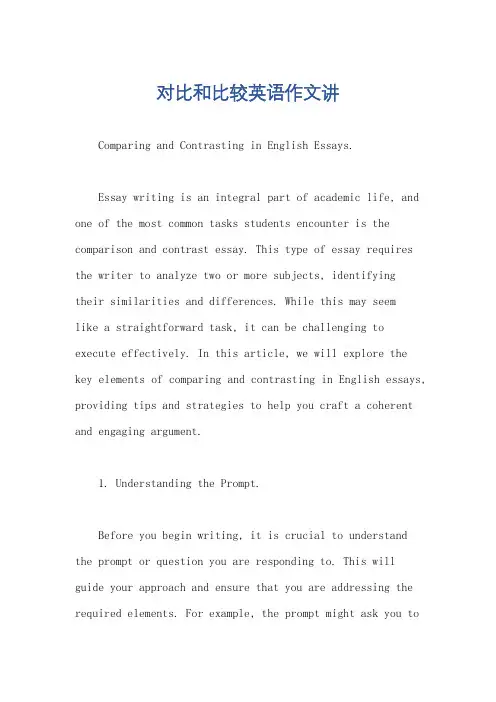
对比和比较英语作文讲Comparing and Contrasting in English Essays.Essay writing is an integral part of academic life, and one of the most common tasks students encounter is the comparison and contrast essay. This type of essay requires the writer to analyze two or more subjects, identifyingtheir similarities and differences. While this may seemlike a straightforward task, it can be challenging to execute effectively. In this article, we will explore the key elements of comparing and contrasting in English essays, providing tips and strategies to help you craft a coherent and engaging argument.1. Understanding the Prompt.Before you begin writing, it is crucial to understand the prompt or question you are responding to. This will guide your approach and ensure that you are addressing the required elements. For example, the prompt might ask you tocompare and contrast two literary works, or it might focus on analyzing the similarities and differences between two historical events. Understanding the scope and focus of the prompt is essential for shaping your essay.2. Organizing Your Thoughts.Organizing your thoughts is crucial for writing a coherent essay. You should begin by identifying the key points you want to make about each subject. Then, create an outline that organizes these points into a logical structure. This will help you ensure that your essay flows smoothly and that your arguments are clearly presented.3. Focusing on Similarities and Differences.When comparing and contrasting, it is essential to focus on both similarities and differences. This helps to provide a balanced argument and gives the reader a comprehensive understanding of the subjects. Identify common themes, ideas, or characteristics that link the subjects, as well as unique features that distinguish them.4. Using Transitional Words and Phrases.Transitional words and phrases are essential for creating a smooth transition between ideas and paragraphs. They help the reader follow your argument and understand the relationships between different points. For example, you might use words like "similarly," "likewise," or "in contrast" to indicate comparisons or contrasts.5. Providing Evidence and Examples.When making points about the subjects, it is important to provide evidence and examples to support your arguments. This could include quotes from texts, statistical data, or anecdotal evidence. By backing up your claims with solid evidence, you increase the credibility of your essay and help the reader understand your perspective.6. Concluding Thoughtfully.The conclusion is a crucial part of any essay, and itis particularly important in comparison and contrast essays. Here, you should summarize your main points and arguments, highlighting the similarities and differences you have discussed. Additionally, you might want to considerproviding a final thought or insight that ties togetheryour analysis and leaves the reader with a lasting impression.7. Revising and Editing.Finally, revising and editing are essential steps inthe essay writing process. Take time to review your work, checking for grammar errors, spelling mistakes, and inconsistencies in your arguments. Make sure that youressay flows logically and that your ideas are clearly presented. A well-revised and edited essay will convey a more professional and coherent message to the reader.In conclusion, comparing and contrasting in English essays requires a careful balance of analyzing similarities and differences while maintaining a clear and logical structure. By following the tips outlined in this article,you can craft a thought-provoking and engaging essay that effectively addresses the prompt and leaves a lasting impression on your reader.。
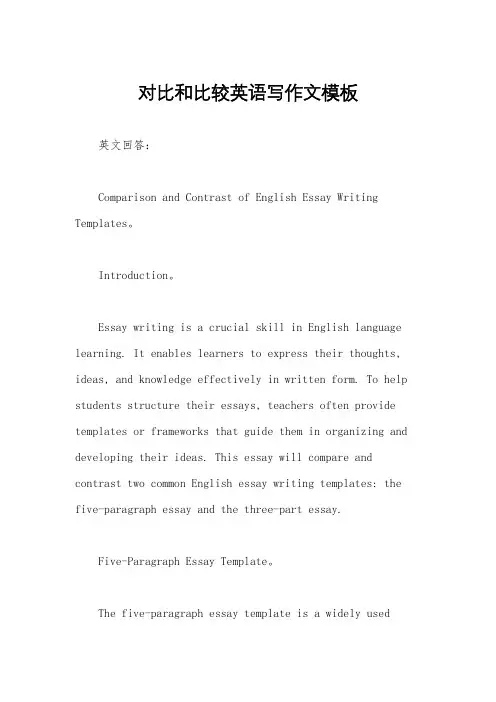
对比和比较英语写作文模板英文回答:Comparison and Contrast of English Essay Writing Templates。
Introduction。
Essay writing is a crucial skill in English language learning. It enables learners to express their thoughts, ideas, and knowledge effectively in written form. To help students structure their essays, teachers often provide templates or frameworks that guide them in organizing and developing their ideas. This essay will compare and contrast two common English essay writing templates: the five-paragraph essay and the three-part essay.Five-Paragraph Essay Template。
The five-paragraph essay template is a widely usedstructure in English writing. It consists of five distinct paragraphs:1. Introduction: This paragraph introduces the topic of the essay, provides a brief overview of the main points, and includes a thesis statement that states the main argument or claim.2. Body Paragraph 1: This paragraph presents the first supporting point for the thesis statement, providing evidence, examples, or explanations.3. Body Paragraph 2: This paragraph presents the second supporting point for the thesis statement, providingfurther evidence, examples, or explanations.4. Body Paragraph 3: This paragraph presents the third and final supporting point for the thesis statement, providing additional evidence, examples, or explanations.5. Conclusion: This paragraph restates the thesis statement, summarizes the main points, and provides aconcluding statement that reinforces the essay's argument.Three-Part Essay Template。
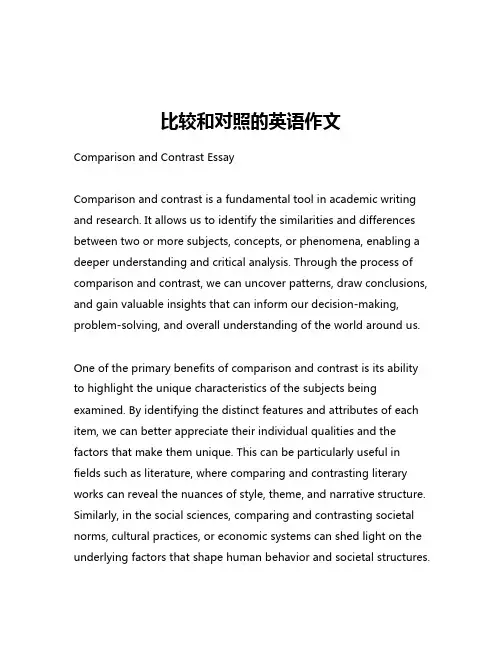
比较和对照的英语作文Comparison and Contrast EssayComparison and contrast is a fundamental tool in academic writing and research. It allows us to identify the similarities and differences between two or more subjects, concepts, or phenomena, enabling a deeper understanding and critical analysis. Through the process of comparison and contrast, we can uncover patterns, draw conclusions, and gain valuable insights that can inform our decision-making, problem-solving, and overall understanding of the world around us.One of the primary benefits of comparison and contrast is its ability to highlight the unique characteristics of the subjects being examined. By identifying the distinct features and attributes of each item, we can better appreciate their individual qualities and the factors that make them unique. This can be particularly useful in fields such as literature, where comparing and contrasting literary works can reveal the nuances of style, theme, and narrative structure. Similarly, in the social sciences, comparing and contrasting societal norms, cultural practices, or economic systems can shed light on the underlying factors that shape human behavior and societal structures.Another important aspect of comparison and contrast is its role in facilitating critical thinking and analysis. By systematically examining the similarities and differences between two or more subjects, we are forced to engage in a deeper level of scrutiny and evaluation. This process encourages us to question our assumptions, challenge our preconceptions, and consider alternative perspectives. As we delve into the intricacies of the comparison, we may uncover unexpected connections or discover previously overlooked aspects, leading to a more comprehensive and nuanced understanding of the topic at hand.Furthermore, comparison and contrast can be a powerful tool for decision-making and problem-solving. By carefully weighing the pros and cons of different options, we can make more informed and strategic choices. This is particularly relevant in fields such as business, where comparing and contrasting various products, services, or strategies can inform investment decisions, marketing strategies, and organizational planning. In the realm of personal decision-making, comparing and contrasting alternatives can help us navigate complex choices and arrive at the most suitable solution.Additionally, the process of comparison and contrast can enhance our communication and writing skills. By organizing and presenting our findings in a clear and structured manner, we can effectively convey our ideas to our audience. This skill is crucial in academic,professional, and personal settings, where the ability to articulate complex ideas and persuade others is highly valued.In conclusion, comparison and contrast is a versatile and essential tool that has numerous applications across various disciplines and spheres of life. Whether we are analyzing literary works, evaluating societal trends, or making critical decisions, the process of comparison and contrast can provide us with invaluable insights, foster critical thinking, and enhance our communication and problem-solving abilities. By embracing the power of comparison and contrast, we can deepen our understanding, sharpen our analytical skills, and make more informed and effective choices.。

对比比较英文作文范文模板Title: Comparative Analysis: English Essay Template。
Introduction:In contemporary academic discourse, the ability to compare and contrast is often valued as a crucial skill. Whether in literature, history, or science, the skill of drawing parallels and distinctions can illuminate insights and deepen understanding. In this essay, we will delve into a comparative analysis of English essay templates, exploring their structures, elements, and effectiveness.Thesis Statement:Through a comparative examination of various English essay templates, we aim to elucidate their distinctive features, strengths, and weaknesses, thereby providing valuable insights for aspiring writers.Body:1. Traditional Five-Paragraph Essay Template:Introduction:Hook: Engage the reader's attention with a compelling opening statement or question.Background Information: Provide context or background information relevant to the topic.Thesis Statement: Present the main argument or point of view that the essay will explore.Body Paragraphs (Three):Topic Sentence: Introduce the main idea or argument of the paragraph.Supporting Evidence: Provide evidence, examples, or quotations to support the topic sentence.Analysis: Analyze and interpret the significance of the evidence in relation to the thesis.Transition: Connect the current paragraph to the next one.Conclusion:Restate Thesis: Recapitulate the main argument presented in the essay.Summary of Main Points: Summarize the key points discussed in the body paragraphs.Concluding Statement: Offer a final thought, recommendation, or call to action.2. Comparative Essay Template:Introduction:Contextual Background: Provide a brief overview of the two subjects being compared.Thesis Statement: Present the main argument regarding the similarities and differences between the subjects.Body Paragraphs (Multiple):Point-by-Point Comparison: Compare and contrast specific aspects of the two subjects in each paragraph.Evidence and Analysis: Support comparisons with evidence, examples, or statistics, followed by analysis.Transition: Ensure smooth transitions between paragraphs to maintain coherence.Conclusion:Recapitulation of Thesis: Restate the main argument regarding the compared subjects.Summary of Comparisons: Summarize the key similarities and differences highlighted in the essay.Concluding Insight: Offer a concluding thought or insight derived from the comparative analysis.3. Argumentative Essay Template:Introduction:Opening Statement: Begin with a bold assertion or statement relevant to the topic.Background Information: Provide necessary context or background information to orient the reader.Thesis Statement: Present a clear and debatable claim or position that the essay will defend.Body Paragraphs (Multiple):Claim and Counterclaim: Present the main argument and anticipate potential counterarguments.Evidence and Rebuttal: Support the claim with evidence while addressing and refuting counterarguments.Transition: Ensure logical progression between paragraphs for coherence.Conclusion:Reinforcement of Thesis: Emphasize the validity and significance of the main argument.Synthesis of Arguments: Summarize the main points and arguments presented in the essay.Call to Action or Implication: Conclude with a call to action, implication, or suggestion for further exploration.Conclusion:In conclusion, the comparative analysis of Englishessay templates reveals diverse structures and approaches tailored to different rhetorical purposes and contexts. While the traditional five-paragraph essay template offersa straightforward structure for presenting arguments, the comparative and argumentative templates provide flexibility for analyzing relationships between subjects and defending complex claims, respectively. By understanding the nuancesof each template, writers can effectively navigate various writing tasks and engage readers with clarity and coherence.。

![美国大学英语写作:Chapter 13_对比和比较[优质ppt]](https://uimg.taocdn.com/8e3b86177375a417866f8f42.webp)
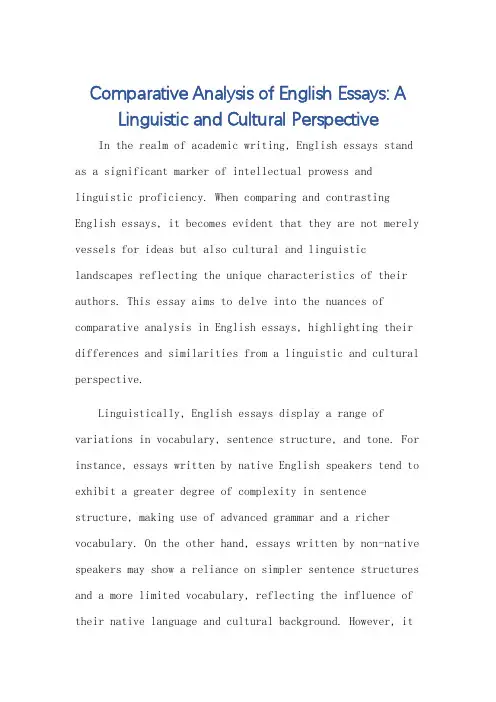
Comparative Analysis of English Essays: A Linguistic and Cultural PerspectiveIn the realm of academic writing, English essays stand as a significant marker of intellectual prowess and linguistic proficiency. When comparing and contrasting English essays, it becomes evident that they are not merely vessels for ideas but also cultural and linguistic landscapes reflecting the unique characteristics of their authors. This essay aims to delve into the nuances of comparative analysis in English essays, highlighting their differences and similarities from a linguistic and cultural perspective.Linguistically, English essays display a range of variations in vocabulary, sentence structure, and tone. For instance, essays written by native English speakers tend to exhibit a greater degree of complexity in sentence structure, making use of advanced grammar and a richer vocabulary. On the other hand, essays written by non-native speakers may show a reliance on simpler sentence structures and a more limited vocabulary, reflecting the influence of their native language and cultural background. However, itis noteworthy that even non-native speakers can achieve a high level of linguistic proficiency in English essays with sufficient practice and exposure.Cultural differences also play a pivotal role in the comparative analysis of English essays. Essays written by authors from different cultures often reflect their unique worldviews, values, and beliefs. For instance, essays from Western cultures may emphasize logic, rationality, and objectivity, while essays from Eastern cultures may prioritize harmony, subjectivity, and contextual understanding. These cultural differences can significantly influence the way authors approach their topics, organize their arguments, and convey their ideas.Despite these differences, there are also significant similarities in English essays across cultures. Firstly, English essays, regardless of their cultural background, aim to convey clear and coherent arguments supported by evidence and analysis. Secondly, they all require a high degree of organization and coherence, ensuring that the reader can follow the argument from beginning to end. Lastly, English essays share a common goal of promotingcritical thinking and intellectual growth, encouraging authors to explore and evaluate ideas from multiple perspectives.In conclusion, the comparative analysis of English essays offers a fascinating glimpse into the intersectionof language, culture, and intellectual pursuits. Whilethere are significant differences in linguistic proficiency and cultural perspectives across essays, they also share common goals and standards of academic writing. Understanding these differences and similarities is crucial for effective cross-cultural communication and intellectual exchange.**英语作文对比与评析:语言与文化的双重视角**在学术写作领域,英语作文作为一种重要的思想表达和语言能力的体现,具有显著的地位。
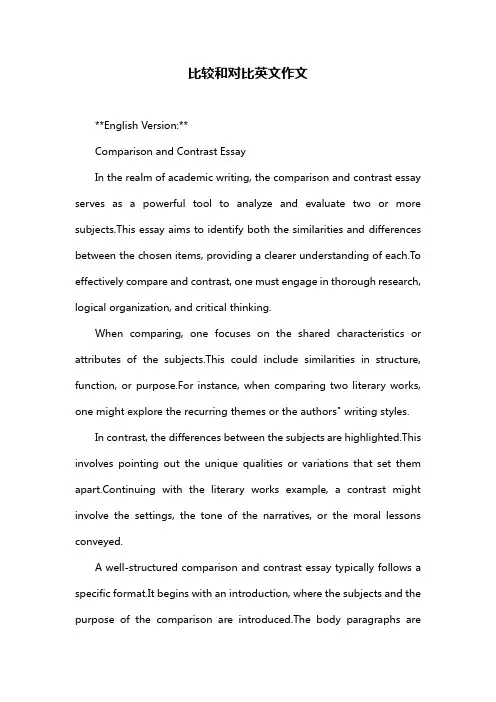
比较和对比英文作文**English Version:**Comparison and Contrast EssayIn the realm of academic writing, the comparison and contrast essay serves as a powerful tool to analyze and evaluate two or more subjects.This essay aims to identify both the similarities and differences between the chosen items, providing a clearer understanding of each.To effectively compare and contrast, one must engage in thorough research, logical organization, and critical thinking.When comparing, one focuses on the shared characteristics or attributes of the subjects.This could include similarities in structure, function, or purpose.For instance, when comparing two literary works, one might explore the recurring themes or the authors" writing styles.In contrast, the differences between the subjects are highlighted.This involves pointing out the unique qualities or variations that set them apart.Continuing with the literary works example, a contrast might involve the settings, the tone of the narratives, or the moral lessons conveyed.A well-structured comparison and contrast essay typically follows a specific format.It begins with an introduction, where the subjects and the purpose of the comparison are introduced.The body paragraphs arewhere the analysis occurs; each paragraph addressing a specific aspect of comparison or contrast.Finally, the conclusion sums up the main points and often provides insight into the significance of the comparison.To write an effective essay, it is crucial to:1.Select subjects that can be reasonably compared or contrasted.e clear and logical transitions between points.3.Provide evidence and examples to support each comparison or contrast.4.Avoid stating facts without analysis.5.End with a strong conclusion that emphasizes the value of the comparison.The comparison and contrast essay is a valuable genre that enhances critical thinking skills and promotes a deeper understanding of the subject matter.**中文版本:**比较与对比作文在学术写作领域,比较与对比作文是一种强大的分析工具,用于评估两件或更多事物。
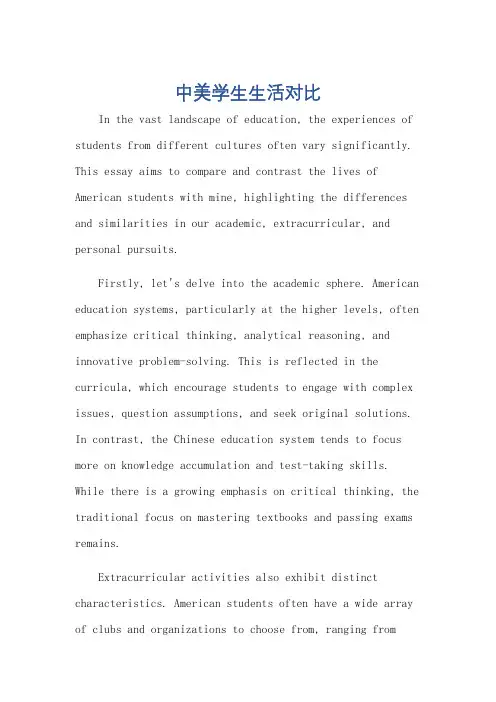
中美学生生活对比In the vast landscape of education, the experiences of students from different cultures often vary significantly. This essay aims to compare and contrast the lives of American students with mine, highlighting the differences and similarities in our academic, extracurricular, and personal pursuits.Firstly, let's delve into the academic sphere. American education systems, particularly at the higher levels, often emphasize critical thinking, analytical reasoning, and innovative problem-solving. This is reflected in the curricula, which encourage students to engage with complex issues, question assumptions, and seek original solutions. In contrast, the Chinese education system tends to focus more on knowledge accumulation and test-taking skills. While there is a growing emphasis on critical thinking, the traditional focus on mastering textbooks and passing exams remains.Extracurricular activities also exhibit distinct characteristics. American students often have a wide array of clubs and organizations to choose from, ranging fromsports teams to academic clubs and social organizations. These provide ample opportunities for students to pursue their passions, develop leadership skills, and build social networks. By contrast, while extracurricular activities are also prevalent in China, they tend to be more focused on academic competitions and preparation for future professions.In terms of personal pursuits, American students often enjoy a greater degree of freedom and choice. They are encouraged to explore their interests, whether it be through hobbies, travel, or part-time work. This fosters a culture of independence and self-discovery. By contrast, Chinese students, while also having interests and hobbies, often face greater pressure to prioritize academic success, which can sometimes limit their opportunities for personal growth and exploration.However, despite these differences, there are also significant similarities. Both American and Chinese students share a common goal of achieving academic excellence and preparing for future careers. We both strive to master new knowledge, develop critical thinking skills,and cultivate leadership qualities. Furthermore, we both face challenges and pressures, whether it be exam stress, career uncertainty, or the pursuit of personal goals.In conclusion, while there are numerous differences in the lives of American students and mine, there are also many similarities. Both systems have their strengths and weaknesses, and it is important to recognize and appreciate the diversity of educational experiences worldwide. Bydoing so, we can gain a broader perspective, enhance our understanding of other cultures, and ultimately, grow as individuals and as global citizens.**中美学生生活对比**在教育的广阔天地中,来自不同文化背景的学生的经历往往大相径庭。
英语对比类型文章模板作文Title: Comparison and Contrast Essay Template。
Introduction:In today's world, comparison and contrast essays are commonly assigned in schools and universities. This type of essay requires students to analyze the similarities and differences between two or more subjects. By examining these similarities and differences, students can gain a deeper understanding of the subjects being compared. Inthis essay, we will explore the structure and key components of a comparison and contrast essay.Body Paragraph 1:One of the key components of a comparison and contrast essay is the introduction. In the introduction, the writer should provide a brief overview of the subjects being compared and explain why they are being compared.Additionally, the introduction should include a thesis statement that clearly states the writer's main argument. For example, if the essay is comparing and contrasting two different types of music, the thesis statement might be: "While both jazz and classical music are forms of art, they differ in their origins, instrumentation, and improvisational techniques."Body Paragraph 2:After the introduction, the writer should move on to the body paragraphs of the essay. Each body paragraph should focus on a specific point of comparison or contrast between the subjects. For example, one body paragraph might compare the origins of jazz and classical music, while another body paragraph might compare their instrumentation. Within each body paragraph, the writer should provide evidence to support their claims, such as examples, statistics, or quotations from experts in the field.Body Paragraph 3:In addition to providing evidence, the writer should also use transitional words and phrases to guide the reader through the essay. Transitional words and phrases help to establish connections between ideas and create a smooth flow of information. For example, transitional words like "however," "in contrast," and "similarly" can be used to signal shifts between points of comparison or contrast.Body Paragraph 4:Another important component of a comparison and contrast essay is the conclusion. In the conclusion, the writer should summarize the main points of the essay and restate the thesis statement. Additionally, the writer should offer some final thoughts on the subjects being compared and suggest possible areas for further research or discussion. By ending the essay on a strong note, thewriter can leave a lasting impression on the reader.Conclusion:In conclusion, comparison and contrast essays are aneffective way for students to develop their critical thinking skills and deepen their understanding of different subjects. By following the structure and key components outlined in this essay, students can create well-organized and persuasive comparison and contrast essays. With practice and perseverance, students can master the art of comparing and contrasting and become more adept at analyzing the world around them.。
英语写作比较和对比范文Title: The Beauty of Contrast: Comparing Traditionaland Modern Forms of Art.Art, in its various forms, has always been a reflection of society, culture, and the times. The evolution of art over the centuries has been fascinating, with each period leaving its unique imprint on the canvas. This essay aimsto compare and contrast traditional and modern forms of art, exploring the differences and similarities that define them.Traditional Art.Traditional art, often rooted in historical andcultural contexts, has a sense of permanence and stability. It is often associated with specific geographical regions, reflecting the values, beliefs, and aesthetics of aparticular community or era. Traditional artists often draw inspiration from nature, mythology, and religious texts, creating works that are both visually appealing and deeplysymbolic.The techniques used in traditional art are often well-established and passed down through generations. These techniques, whether it be painting, sculpture, or embroidery, require years of practice and mastery. The finished works are often highly detailed, with every stroke, line, and color carrying deep meaning and symbolism.Modern Art.In contrast, modern art is often associated with innovation, experimentation, and a rejection of traditional norms. It emerged in the late 19th and early 20th centuries, challenging the established artistic canons and pushing the boundaries of what was considered acceptable in art.Modern artists explored new mediums, techniques, and subject matter, often focusing on abstract or non-representational forms. They aimed to express their feelings, thoughts, and ideas through their works, rather than simply creating visually appealing images. Thefinished works are often jarring, unexpected, and thought-provoking.Comparison and Contrast.While traditional and modern art might seem vastly different at first glance, they share certain fundamental principles. Both forms of art aim to communicate a message or evoke a feeling in the viewer. They both require creativity, skill, and dedication to create meaningful works.However, the methods and means through which they achieve these goals are vastly different. Traditional art relies on established techniques and subject matter, while modern art pushes the boundaries of what is considered acceptable. Traditional art is often rooted in history and culture, while modern art is often experimental and innovative.The reception of these two forms of art also differs. Traditional art is often admired and appreciated for itscraftsmanship and historical significance, while modern art can be polarizing, with some finding it confusing or even offensive.Conclusion.In conclusion, traditional and modern art are twodistinct yet complementary forms of expression. They each have their unique strengths and weaknesses, and their differences reflect the changing times and societal values. By comparing and contrasting these two forms of art, wegain a deeper understanding of not only the art itself but also the cultures and values that shaped them.The beauty of art lies in its ability to evoke feelings, thoughts, and ideas in the viewer. Whether it is theintricate detailing of a traditional painting or theabstract expressions of a modern sculpture, art has the power to move us in profound ways. By embracing both traditional and modern forms of art, we open ourselves to a richer, more diverse, and ultimately more fulfillingartistic experience.。
大学英文作文对比英文:When it comes to the topic of comparison, there are always two sides to every story. On one hand, comparing things can help us make informed decisions and understandthe differences between them. On the other hand, comparing things can lead to feelings of inadequacy and self-doubt.Personally, I believe that comparison can be bothhelpful and harmful, depending on how we approach it. If we use comparison as a tool for learning and growth, it can be incredibly beneficial. For example, if I compare my writing to that of a more experienced writer, I can identify areas where I need to improve and work to develop my skills.However, if we use comparison to judge ourselves or others, it can be damaging to our self-esteem. For instance, if I constantly compare myself to someone who is more successful than me, I may begin to feel like a failure andlose motivation.Overall, I think it's important to approach comparison with a balanced perspective. We should use it as a tool for growth and improvement, but also be mindful of how itaffects our mental health and self-esteem.中文:谈到比较这个话题,每个故事都有两面。
英文比较对比作文模板范文Comparison and Contrast Essay Template and Sample。
Introduction:When it comes to writing a comparison and contrast essay, it is important to have a clear understanding of the purpose and structure of this type of essay. This essay is used to compare and contrast two or more things, people, events, or ideas and to show the similarities and differences between them. In this essay, we will discuss the template for writing a comparison and contrast essay and provide a sample essay to illustrate the key points.Template for Comparison and Contrast Essay:1. Introduction:The introduction should provide some background information on the topic and present the thesis statement,which states the main purpose of the essay and the points that will be compared and contrasted.2. Body Paragraphs:The body paragraphs should present the points of comparison and contrast in a clear and organized manner. Each paragraph should focus on a specific aspect of the comparison and contrast and provide evidence and examples to support the points being made.3. Point-by-Point Comparison:One way to structure a comparison and contrast essay is to use a point-by-point method. In this method, each paragraph focuses on a specific point of comparison or contrast. For example, if you are comparing two different types of cars, you could have a paragraph discussing the fuel efficiency of each car, another paragraph discussing the safety features, and another paragraph discussing the cost of maintenance.4. Block Comparison:Another way to structure a comparison and contrast essay is to use a block method. In this method, the writer discusses all the points of one subject and then all the points of the other subject. This method can be useful when the two subjects being compared are quite different and it is easier to understand them when they are discussed separately.5. Conclusion:The conclusion should summarize the main points of the essay and restate the thesis statement. It should also provide a final thought or opinion on the topic and leave the reader with something to think about.Sample Comparison and Contrast Essay:Topic: Comparison of City Life and Country Life。
对比比较英语作文写作模板Comparison and Contrast English Composition Writing Template。
When it comes to writing an English composition, there are various ways to approach the task. One of the most effective methods is through the use of comparison and contrast. This technique allows the writer to explore the similarities and differences between two or more subjects, providing a deeper understanding of the topic at hand. In this article, we will discuss the key components of a comparison and contrast English composition writing template.Introduction:The introduction sets the stage for the rest of the composition. It should provide a brief overview of the subjects being compared and contrasted, as well as a clear thesis statement that outlines the main points of the composition. The introduction should also grab the reader's attention and make them interested in the topic.Body Paragraphs:The body paragraphs of a comparison and contrast English composition should focus on the similarities and differences between the subjects. Each paragraph should address a specific point of comparison or contrast, and provide evidence to support the writer's claims. It is important to use clear and concise language, and to organize the information in a logical manner. Additionally, the writer should use transition words and phrases to guide the reader through the composition and make connections between the different points being discussed.Conclusion:The conclusion of a comparison and contrast English composition should summarize the main points of the composition and restate the thesis statement. It should also provide some insight or reflection on the significance of the comparisons and contrasts that weremade. The conclusion should leave the reader with a sense of closure and a deeper understanding of the topic.Example:To illustrate this template, let's consider an example of a comparison and contrast English composition. Suppose we are comparing and contrasting the benefits of living in a city versus living in the countryside. The introduction would provide a brief overview of the topic and a thesis statement outlining the main points of the composition. The body paragraphs would then focus on specific aspects of city and countryside living, such as cost of living, access to amenities, and quality of life. Each paragraph would provide evidence to support the writer's claims, and use transition words and phrases to guide the reader through the composition. Finally, the conclusion would summarize the main points of the composition and provide some insight into the significance of the comparisons and contrasts that were made.In conclusion, a comparison and contrast English composition writing template is a useful tool for exploring the similarities and differences between two or more subjects. By following the key components outlined in this article, writers can create effective and engaging compositions that provide a deeper understanding of the topic at hand. Whether comparing and contrasting different cultures, historical events, or literary works, this template can be applied to a wide range of topics and subjects.。